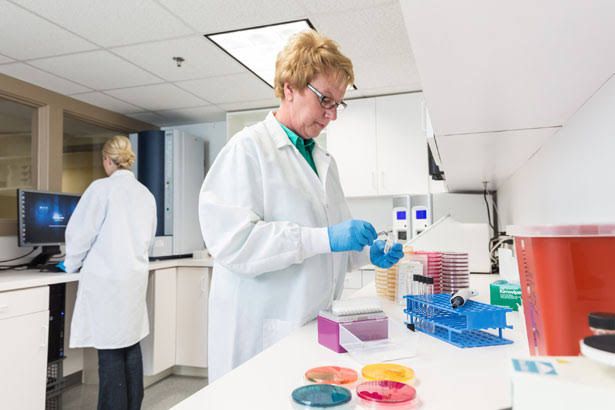
Transformation is a process where foreign DNA is introduced into a bacterial cell, allowing the bacteria to acquire new traits, such as antibiotic resistance. In this procedure, we will focus on transforming Escherichia coli (E. coli) with a plasmid that carries the gene for ampicillin resistance.
Materials Required
- Competent Cells: E. coli cells that are prepared to take up DNA.
- Plasmid DNA: A plasmid containing the ampicillin resistance gene (ampR).
- LB Agar Plates: Nutrient agar plates supplemented with ampicillin.
- LB Broth: Liquid medium for bacterial growth.
- Microcentrifuge Tubes: For mixing samples.
- Ice Bucket: To keep samples cold during incubation.
- Water Bath: Set at 42°C for heat shock.
- Shaking Incubator: Set at 37°C for bacterial growth.
Step-by-Step Procedure
Step i: Preparation of Competent Cells
- Thaw competent E. coli cells on ice for about 20-30 minutes to ensure they remain cold and viable.
- Once thawed, handle the cells gently to avoid damaging them.
Step ii: Mixing Plasmid DNA with Competent Cells
- Add 1-5 μL of plasmid DNA (typically between 10 pg and 100 ng) into a microcentrifuge tube containing 20-50 μL of competent cells.
- Gently mix the solution by flicking the bottom of the tube or pipetting up and down carefully.
Step iii: Incubation on Ice
- Place the mixture on ice for an additional 20-30 minutes to allow the plasmid DNA to interact with the competent cells.
Step iv: Heat Shock Treatment
- After incubation on ice, perform a heat shock by placing the bottom half of the microcentrifuge tube in a water bath set at 42°C for approximately 30-60 seconds (45 seconds is often optimal).
- Immediately return the tubes to ice for about 2 minutes after heat shocking.
Step v: Recovery Phase
- Add 250-1000 μL of LB broth (without antibiotics) to each tube containing transformed cells.
- Incubate these tubes in a shaking incubator at 37°C for about 45 minutes to allow expression of antibiotic resistance genes.
Step vi: Plating Transformed Cells
- After recovery, plate some or all of the transformation mixture onto LB agar plates that contain ampicillin (the concentration should be appropriate based on your experimental design).
- It is advisable to plate different volumes (e.g., 50 μL on one plate and remaining volume on another) to optimize colony formation.
Step vii: Incubation of Plates
- Incubate the agar plates overnight at 37°C.
- During this time, only those bacteria that have successfully taken up the plasmid will grow due to their acquired ampicillin resistance.
Confirmation of Transformation
After incubation, colonies that appear on the agar plates can be screened further:
- Pick individual colonies and culture them in selective media containing ampicillin.
- Use techniques such as PCR or restriction digestion analysis to confirm that these colonies carry the plasmid with the ampicillin resistance gene.
Conclusion
This step-by-step procedure outlines how E. coli can be transformed with an ampicillin-resistant plasmid through careful preparation and handling techniques, ensuring successful uptake and expression of foreign DNA within bacterial cells.







